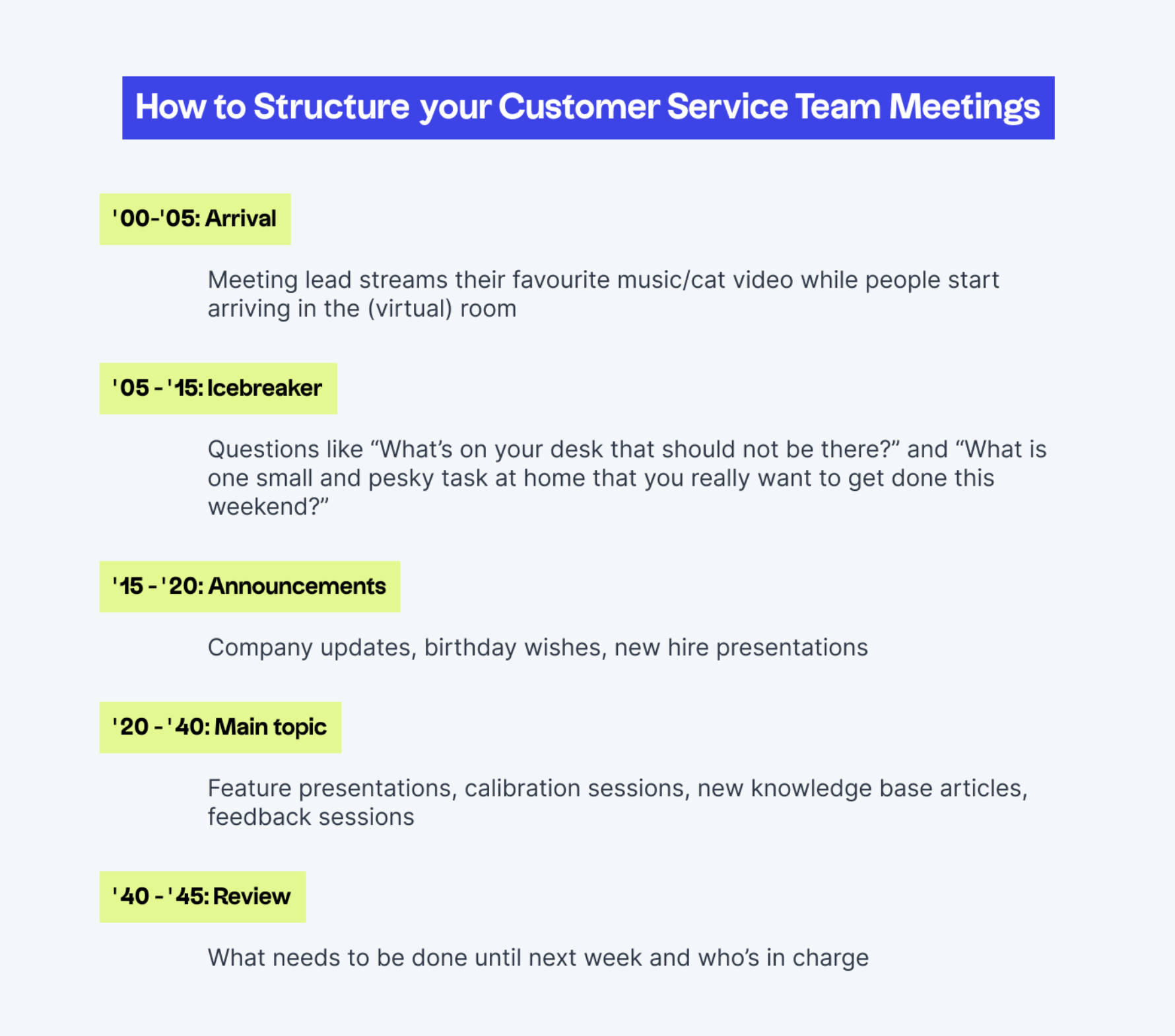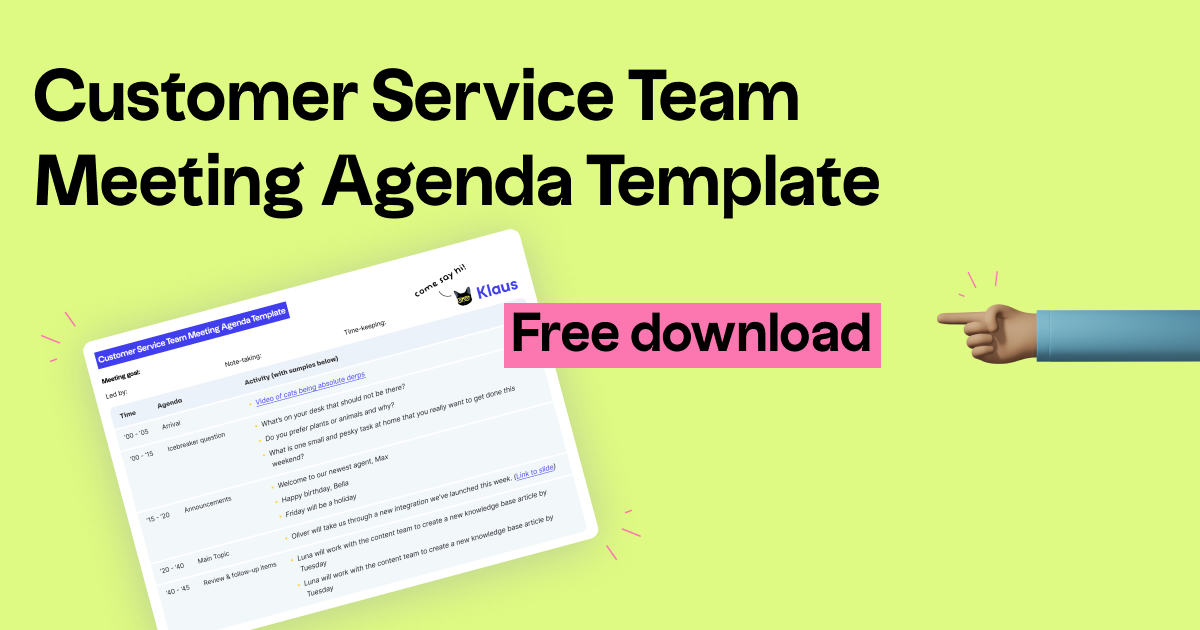Customer service team meetings are a great platform to discuss changes, ideas, and challenges that affect your support team.
When done effectively, it can result in better decision-making and higher team chemistry.
However, all too often we see these meetings become boring, monotonous, and something that exists to purely tick a box.
With participants dreading them as much as a cat does water.
Luckily, we’re not going to allow you to fall into that trap (or bathtub if you’re a cat).
By the end of this article, you’ll know exactly how to get the most out of your weekly meetings with your very own 45-minute customer service team meeting agenda template.
Along with our top tips to make these meetings as engaging and productive as possible.
So without further ado, let’s jump right in!
Customer service team meeting agenda

Customer service team meetings might well be one of the few social interactions, not focused on solving a specific problem around customer interactions, your support agents have all week.
So it’s really important to make every single minute count.
To help you do just that, we’ve outlined how you can plan every one of those 45 minutes.
Arrival (5 minutes)
Whether it’s a physical space or a Zoom room, it’s unlikely that you’ll have every single participant ready to go at the time you’ve set.
Now, of course, punctuality is something that you should aspire to.
But internet issues, last-minute support tickets, and life, in general, can come in the way to affect the best of us.
So, it makes sense to have a designated 5-minute buffer time that allows everyone to trickle in without missing anything important.
Having the meeting lead stream their favorite music, cat video or anything else light-hearted are some ways to get the ball rolling while all the participants gradually arrive.
Icebreaker (10 minutes)
The success of your team meetings ultimately depends on how well you’re able to encourage your support agents to open up and participate.
Having a fun icebreaker activity to start off helps you take a step in this direction.
Not only does it ease the participants into the meeting but gives your team a chance to bond over ‘non-work-related’ things as well.

The icebreaker activity you use can be in the form of questions like:
- What’s on your desk that shouldn’t be there?
- Do you prefer plants or animals? Why?
- What is one small and pesky task at home that you really want to get done this weekend?
A simple online search of the phrase ‘icebreaker questions’ will help you find more than enough topics to choose from.
Remember, healthy communication between your team doesn’t just happen by itself. Instead, you need to intentionally create the foundations for it to happen. And taking part in an activity that everyone enjoys is one such way to do just that!
Announcements (5 minutes)
Once you’re done with a round of icebreakers that has everyone sufficiently warmed up, you can start jumping into the more ‘serious’ stuff.
A good way to make this transition is by sharing company announcements, birthday wishes, new hire presentations, or things of that nature.
You can even use this space to shout out teammates that deserve one so that your entire team can recognize their good work.
Main topic (20 minutes)
Great, we’re now at the actual meat of the meeting.
These are topics that you want to discuss in-depth to make sure everyone is on the same page with new developments, changes, bugs, features, etc.
For your support team, the main topic might include things like:
- Feature presentations
- Calibration sessions
- New knowledge base articles
- Feedback sessions
Now, how exactly you spend these 20 minutes, depends on the kind of topic you’re covering.
So, for example:
If you have a new feature release the team lead or someone from the product team simply makes a presentation about how it works.
If it’s a calibration session, the tickets chosen in advance are reviewed by everyone and discussed together.
And if there are new knowledge base articles, you’ll just give your team time to go through them and file questions much like in the famous ‘Amazon document meetings’.
Review (5 minutes)
If you want to see tangible results from your meetings, it’s essential to follow up on all the things you’ve discussed and the action you want to take.
Documenting your next steps and assigning tasks and deadlines also helps keep your team accountable.
So use the last 5 minutes of each meeting to review the different things that need to be done and who needs to do them.
Pro tips to run productive support meetings
So you now know how to organize your support team meetings from start to finish.
But you still may be wondering about things like:
- Who should create the agenda?
- What tools should you use during these meetings?
- How do you make sure the meetings don’t bore everyone to sleep?
Obviously, we couldn’t leave you hanging. So below are the answers to all your questions and more.

Set clear outcomes for every meeting
This is a 45-minute time slot that you only get once a week. So it’s extremely important that every participant feels like it’s a good use of their time.
Make sure you set clear goals for each of your meetings. You can also make it a practice to share the agenda in advance so that everyone is on the same page and knows exactly what you’re trying to achieve.
This will also give other members the chance to suggest topics that they think are worth discussing together.
Team meetings are an important tool for connection. But they should also have a purpose other than just meeting for the sake of it.
Avoid holding meetings for things that can just as easily be communicated via email or Slack. In fact, this will also show your team that you value their time and wouldn’t call for a meeting if it wasn’t necessary.
Get your team to feel comfortable to participate
One of the big challenges of team meetings is getting your different team members to actively participate.
Very often, the reason for this is that team members feel overwhelmed with the social aspect of the meeting.
We’ve already touched upon how important it is to set the tone with icebreakers. But here are some other things to help make your meetings more accessible to everybody:
- Schedule your meetings at a time that works for everyone
- Show everyone how to stream music/videos for the arrival
- Share a list of icebreaker questions to choose from in advance
- Support different types of communication styles (verbal and written)
Also, make it a point to connect individually to better understand the obstacles to participation during your 1-to-1s with your support agents. And then actively work on trying to remove them.
Assign roles and rotate responsibilities
Another great way to get your team more involved in meetings is to assign roles to different members.
The main ones are:
- Meeting lead (who creates the agenda as well)
- Note-taker
- Time-keeper
These roles should be rotated every week. While not everyone will love it, it’s still a great practice to increase investment into what’s happening.
A simple and fair way to go about this is in alphabetical order.
We’d also recommend that the person taking notes one week should be responsible for setting the agenda for the next week. This is because they will be in the best position to know all the things which require a follow-up.
Choose the technology you use wisely
The kind of technology you use for your support team meetings comes down to your personal preferences. But in reality, you don’t need a whole lot.
A video conferencing software to meet (if you’re meeting remotely), a note-taking app, and a timer are really all you need.
There are also other tools like (Miro, for example) that you can use to foster creativity and for calibration sessions respectively.
Experiment and see what works best for your team. But in general, as these meetings are weekly, keep it relatively low-key.
Mix things up and get feedback from your team
The last thing you want your team meetings to be seen as being is boring or a waste of time.
One way to keep things fresh is by alternating topics. So for example:
- Week 1: Calibration
- Week 2: Feature review
- Week 3: Knowledge base articles
- Week 4: Social time
Some other things you could also consider are inviting a guest speaker, watching a useful video, learning a new skill together, etc.
Make it a point to collect feedback, ideally immediately after each meeting, from your team and make updates to your process based on their inputs.
No more boring team meow-tings!
In summary, effective customer service team meetings are central to better understanding your agents while also ensuring connection and direction across your team.
Now armed with your support team meeting template and our pro tips, you have no excuse but to knock these sessions out of the park.
So make us purr-oud and never have a bad meow-ting again!
Originally published in June 2022; last updated in February 2024.


